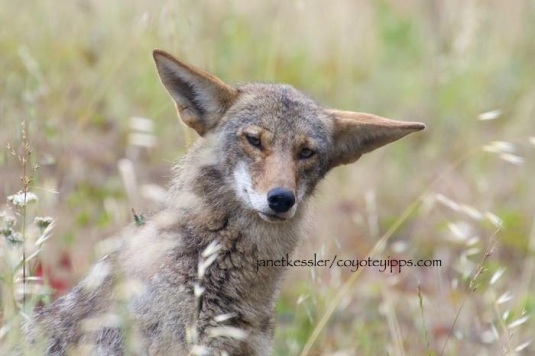
Saturday my leashed dog Holtz and I revisited my Los Angeles area coyotes’ field, taking a shortcut back to the car. Mom showed herself for a few moments and then crept back into the brush. There were also teenagers in the field playing with their assault air rifles. Although my path and theirs didn’t cross I would have liked to hear if they had coyote stories of their own to tell me. As Holtz and I left, the kids were cavorting and shooting their air rifles blindly into the brush, putting an end to my bird and coyote watching. There were many ears and eyes following those kids, all on the move away from them. If the kids decided to actually hunt they would have had trouble finding anything to shoot. Like Holtz, they lack stealth.
Earlier in the week I showed a photo of Mom to my veterinarian who confirmed Mom’s ear was infected or had mites, was a source of discomfort, and would eventually develop into cauliflower ear. Another concern is that this year, the brush in their field is being cut more frequently. In early December the brush was recovering from its earlier mowing, yet in mid-December the brush was mowed yet again. Last June, most of the field was a diverse puppy training ground and a small yet thriving ecosystem. That messy and dull looking area is quite different from both the neighboring golf course and public park. The golf course and park seem as deserts when compared to dull brush. Fortunately we also have a protected 100 acre nature center area that supports an assortment of living things providing each for the other, coyotes and hawks included.
I wonder what, if anything, could or should be done for Mom’s ear. I’ve learned from Janet’s blog that removing a coyote from its environ for treatment is a significant disruption of the group. Her two youngsters, neither yet a year old, still depend on her maturity and skills. Another consideration is that she is or will soon be in season. Holtz has had otitis caught early and the treatment was to irrigate his ears with Betadine followed by daily applications of ointment to his ear canal with oral antibiotics twice a day over a two week period. With Mom, she probably has damage to or a collapse of the ear canal and a cursory web search of the topic suggests treatment at this stage is more complex with no certainty of a successful outcome. Even were resources available to provide treatment, intervening might do more harm than good.
I don’t like that answer. Mom has grown to dislike me just as much as I have grown to love her. I do feel her jobs are of more concern to her than is the discomfort from her ear.
Posting written by Charles Wood. Visit Charles Wood’s website for these and more coyote photos:Charles Wood. His work is copyrighted and may only be used with his explicit permission.






















































